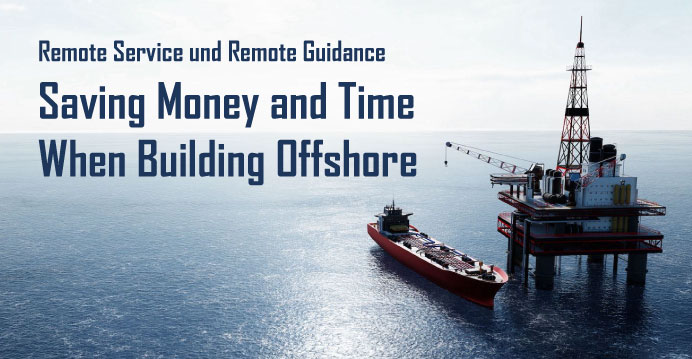Saving Money and Time When Building Offshore

Harder the location is to get to, more money and time the maintenance will cost. Therefore, cutting even a fraction of that inconvenience results in savings on both. Frictape Net Ltd’s business is helideck safety nets and lighting. Sounds simple? Well, they are building offshore: ships, oil platforms and wind farms for example.
To tackle some of the challenges caused by the most working challenging environment and long distances, Frictape Net looked for a solution to smoothen the communication between field staff offshore and management back at the office. The desire was to shave of time lost in waiting and getting field tasks done at once, without errors and more efficiently.
What you need to know about Remote Service
Whenever technical issues get complicated, whenever the task at hand demands specialised technical expertise and deep insight, it would be a huge advantage if this expertise could be provided by a trained technician on site. This principle applies not only to international plant manufacturing, but also to maritime fields of application, as well as offshore structures such as drilling rigs, production platforms, and wind power plants. Considering that, traditionally, it has always been difficult and costly to get experts onto such challenging sites, the current corona pandemic makes this practice almost impossible.
Thus, our current circumstances present the ideal opportunity to introduce practices that will enable us to surmount the difficulties of this pandemic while simultaneously implementing an optimized process that will support businesses for decades to come: Remote Services based on the simple exchange of expert knowledge utilizing Augmented Reality.
“Since we could not be on site, it required two days instead of two minutes for me to find out whether the depth of a drilled hole on the helicopter deck was seven or nine millimeters”
(Jaakko Uotila, Head Of R&D at Frictape Net Ltd.)
Technology has no regard for quarantine restrictions or national shutdowns.
It has to work, nonetheless – and sometimes it does not!
Sometimes it requires maintenance and the question of whether or not the depth of a 7 mm drilling includes the additional top layer of a helicopter deck makes a difference in time of two days.
In any case, the usage of remote service solutions presents a useful, inexpensive, and functioning alternative in regard to industrial remote maintenance. Adventures like those of Jaakko Uotila, are steadily becoming a thing of the past.
Tools like POINTR allow for safe and reliable remote collaboration across national borders and in compliance with all international data safety measures.
Furthermore, POINTR is approved worldwide for security-critical infrastructures. The software solution proves its worth particularly during situations with particular challenges, such as Offshore.
Remote Collaboration Reduces Time Investment While Building Offshore and Increases Productivity
According to experts, even though the number of service and maintenance visits to wind farms on land is higher, the offshore wind farm maintenance takes up much bigger slice of the annual budget. The challenging maintenance visits to take care of offshore wind farms bring the maintenance costs up to a quarter of the plant’s budget. This is when no travel restrictions apply, of course.
However, in heavy seas, the service teams have a particularly hard time due to journeys of several hours, as well as difficult transfers from the ship. Even though helicopter transports are faster, they are more costly and can be canceled on account of weather conditions. Similar concerns apply to more complex platform operations in the open sea. In addition, the multiple effects of the corona pandemic have increased costs even more!
Uotila, whose company specializes in Helideck Safety Net Services, estimates that the time investment of average remotely supervised tasks on offshore structures has increased by 30 to 50 percent due to usage of resources previously available.
That figure alone is alarming enough. Moreover, this additional effort means that the teams on site lose time to deal with all other tasks that may arise. Extra effort, expense and data security threats are incurred if one can only perform remote collaboration via telephone, email or messenger apps such as WhatsApp.
Uotila: “Aside from language barriers and cultural differences, the nonexistent radio circuit on the helicopter deck, where we are working, is particularly hindering in connection with our work. Technicians have to enter an area of the platform that has WLAN coverage to communicate with each other.”
The expert in the control center will have to wait 20 minutes or longer before receiving the answer to a single question. Therefore, two things are at the very top of Uotila’s chief technician’s wish list:
“We require a remote service solution that works via satellite connection and offers the possibility to equip on-site teams with helmet cameras. This allows me to see what they see. Therefore, the POINTR features are ideal for our operations.”
(Saku Korosuo, Rope Access Supervisor at Frictape Net Ltd.)